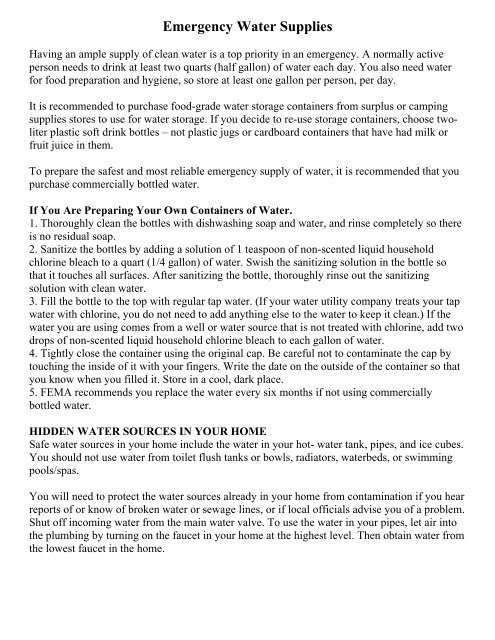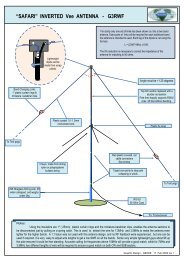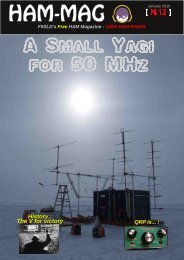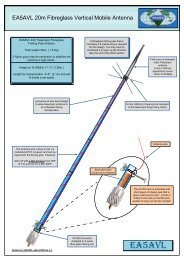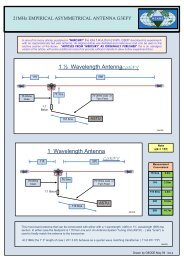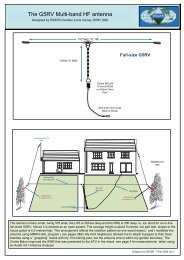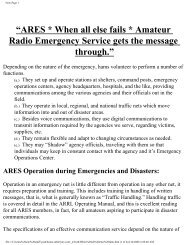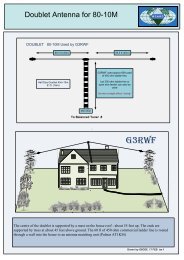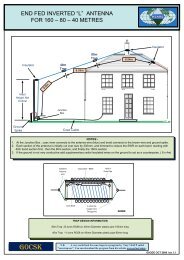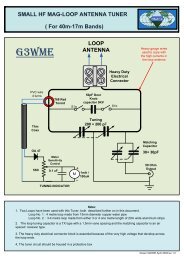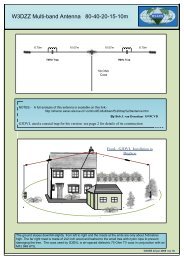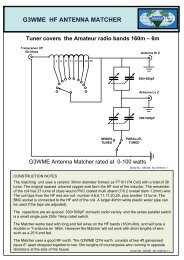Training Scripts/Emergency Water Supplies.pdf - arkansas ares races
Training Scripts/Emergency Water Supplies.pdf - arkansas ares races
Training Scripts/Emergency Water Supplies.pdf - arkansas ares races
Create successful ePaper yourself
Turn your PDF publications into a flip-book with our unique Google optimized e-Paper software.
<strong>Emergency</strong> <strong>Water</strong> <strong>Supplies</strong>Having an ample supply of clean water is a top priority in an emergency. A normally activeperson needs to drink at least two quarts (half gallon) of water each day. You also need waterfor food preparation and hygiene, so store at least one gallon per person, per day.It is recommended to purchase food-grade water storage containers from surplus or campingsupplies stores to use for water storage. If you decide to re-use storage containers, choose twoliterplastic soft drink bottles – not plastic jugs or cardboard containers that have had milk orfruit juice in them.To prepare the safest and most reliable emergency supply of water, it is recommended that youpurchase commercially bottled water.If You Are Preparing Your Own Containers of <strong>Water</strong>.1. Thoroughly clean the bottles with dishwashing soap and water, and rinse completely so thereis no residual soap.2. Sanitize the bottles by adding a solution of 1 teaspoon of non-scented liquid householdchlorine bleach to a quart (1/4 gallon) of water. Swish the sanitizing solution in the bottle sothat it touches all surfaces. After sanitizing the bottle, thoroughly rinse out the sanitizingsolution with clean water.3. Fill the bottle to the top with regular tap water. (If your water utility company treats your tapwater with chlorine, you do not need to add anything else to the water to keep it clean.) If thewater you are using comes from a well or water source that is not treated with chlorine, add twodrops of non-scented liquid household chlorine bleach to each gallon of water.4. Tightly close the container using the original cap. Be careful not to contaminate the cap bytouching the inside of it with your fingers. Write the date on the outside of the container so thatyou know when you filled it. Store in a cool, dark place.5. FEMA recommends you replace the water every six months if not using commerciallybottled water.HIDDEN WATER SOURCES IN YOUR HOMESafe water sources in your home include the water in your hot- water tank, pipes, and ice cubes.You should not use water from toilet flush tanks or bowls, radiators, waterbeds, or swimmingpools/spas.You will need to protect the water sources already in your home from contamination if you hearreports of or know of broken water or sewage lines, or if local officials advise you of a problem.Shut off incoming water from the main water valve. To use the water in your pipes, let air intothe plumbing by turning on the faucet in your home at the highest level. Then obtain water fromthe lowest faucet in the home.
To use the water in your hot-water tank, be sure the electricity or gas is off, and open the drainat the bottom of the tank. Start the water flowing by turning off the water intake valve at thetank and turning on a hot-water faucet.EMERGENCY OUTDOOR WATER SOURCESIf you need to find water outside your home, you can use these sources, but be sure to treat thewater before drinking it.RainwaterStreams, rivers, and other moving bodies of waterPonds and lakesNatural springsWAYS TO TREAT WATERThese instructions are for treating water of uncertain quality in rare emergency situations whenno other reliable clean water source is available and you have used all of your stored water.There are many ways to treat water, though none are perfect. Often the best solution is acombination of methods. Boiling or chlorination will kill most microorganisms but will notremove other contaminants such as heavy metals, salts, and most other chemicals.Boiling is the safest method of treating water. Bring water to a rolling boil for 1 full minute.You can use household liquid bleach to kill microorganisms. Use only regular household liquidbleach that contains 5.25 to 6.0 percent sodium hypochlorite. Do not use scented bleaches,color-safe bleaches, or bleaches with added cleaners. Add 16 drops (1/8 teaspoon) of bleach pergallon of water, stir and let stand for 30 minutes. The water should have a slight bleach odor. Ifit doesn’t, then repeat the dosage and let stand another 15 minutes. If it still does not smell ofbleach, discard it and find another source of water.


